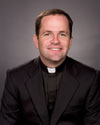Open for Confession 24/7
“Anonymous” asked, “Incidentally when did confession come about? You don't hear about it in the bible or do you? Just interested from a historical perspective.” Thanks, Anon. Christ instituted the Sacrament of Confession (also known as Reconciliation or Penance) when he gave the first priests - the Apostles – the power to forgive sins in John 20:20-23. Also, Christ gave Peter and the Apostles the “keys of the kingdom” (Mt 16 and 18), in which the absolution of sins is included.
For more of the historical perspective of Confession, the following are excerpts (pp. 121-122) from the book, “We Believe” by Oscar Lukefahr, C.M., which we use for our RCIA class here:
“The sacrament of penance has undergone many developments. The earliest evidence indicates that those who sinned after baptism were reconciled to the Church through the bishop. Some heretical groups denied that serious sins such as adultery, apostasy, and murder could be forgiven, but this opinion was condemned by the Council of Nicea in 325, which taught that Christ pardons all repentant sinners. At this time, as a matter of fact, the sacrament of penance was used primarily for the forgiveness of serious sins. Penitents would go through a long period of public penance, particularly in Lent, and were then reconciled to the Church at Easter. In the sixth century, through the influence of Irish monks, penance became generally more available for less serious sins, and private penitential practices replaced the rigorous discipline of earlier times.
In the twelfth century the theology of penance took on dimensions that shaped usage of the sacrament to our own day. Theologians explained that penance included contrition (sorrow and conversion), confession of sins to a priest, satisfaction (doing penance for one’s sins and making up for any harm caused by those sins), and absolution (declaration of forgiveness) by a priest. These four elements were affirmed by the Council of Trent in1551 after the sacraments were questioned by Protestants. By the twentieth century it was common for Catholics to go to confession quite frequently, usually following a set pattern for the sacrament.
Vatican II called for a revision of penance in order to express more clearly its nature and effects. A new Rite of Reconciliation was established in 1974. It expanded the use of Scripture, emphasized the role of the priest as healer in Christ’s name, pointed out the importance of the Church in reconciling us with God, and offered options for the reception of the sacrament”.
On the back of the holy card I made for ordination, it read:
“ ‘Praised by God, the Father of our Lord Jesus Christ, the Father of mercies and the God of all consolation! He comforts us in all our afflictions and thus enables us to comfort those who are in trouble, with the same consolation we have received from Him’ – 2 Cor 1:3-4
Gregory William Shaffer
Ordained a priest forever
May 27, 2006
Open for Confession 24/7”
For more of the historical perspective of Confession, the following are excerpts (pp. 121-122) from the book, “We Believe” by Oscar Lukefahr, C.M., which we use for our RCIA class here:
“The sacrament of penance has undergone many developments. The earliest evidence indicates that those who sinned after baptism were reconciled to the Church through the bishop. Some heretical groups denied that serious sins such as adultery, apostasy, and murder could be forgiven, but this opinion was condemned by the Council of Nicea in 325, which taught that Christ pardons all repentant sinners. At this time, as a matter of fact, the sacrament of penance was used primarily for the forgiveness of serious sins. Penitents would go through a long period of public penance, particularly in Lent, and were then reconciled to the Church at Easter. In the sixth century, through the influence of Irish monks, penance became generally more available for less serious sins, and private penitential practices replaced the rigorous discipline of earlier times.
In the twelfth century the theology of penance took on dimensions that shaped usage of the sacrament to our own day. Theologians explained that penance included contrition (sorrow and conversion), confession of sins to a priest, satisfaction (doing penance for one’s sins and making up for any harm caused by those sins), and absolution (declaration of forgiveness) by a priest. These four elements were affirmed by the Council of Trent in1551 after the sacraments were questioned by Protestants. By the twentieth century it was common for Catholics to go to confession quite frequently, usually following a set pattern for the sacrament.
Vatican II called for a revision of penance in order to express more clearly its nature and effects. A new Rite of Reconciliation was established in 1974. It expanded the use of Scripture, emphasized the role of the priest as healer in Christ’s name, pointed out the importance of the Church in reconciling us with God, and offered options for the reception of the sacrament”.
On the back of the holy card I made for ordination, it read:
“ ‘Praised by God, the Father of our Lord Jesus Christ, the Father of mercies and the God of all consolation! He comforts us in all our afflictions and thus enables us to comfort those who are in trouble, with the same consolation we have received from Him’ – 2 Cor 1:3-4
Gregory William Shaffer
Ordained a priest forever
May 27, 2006
Open for Confession 24/7”


0 Comments:
Post a Comment
<< Home